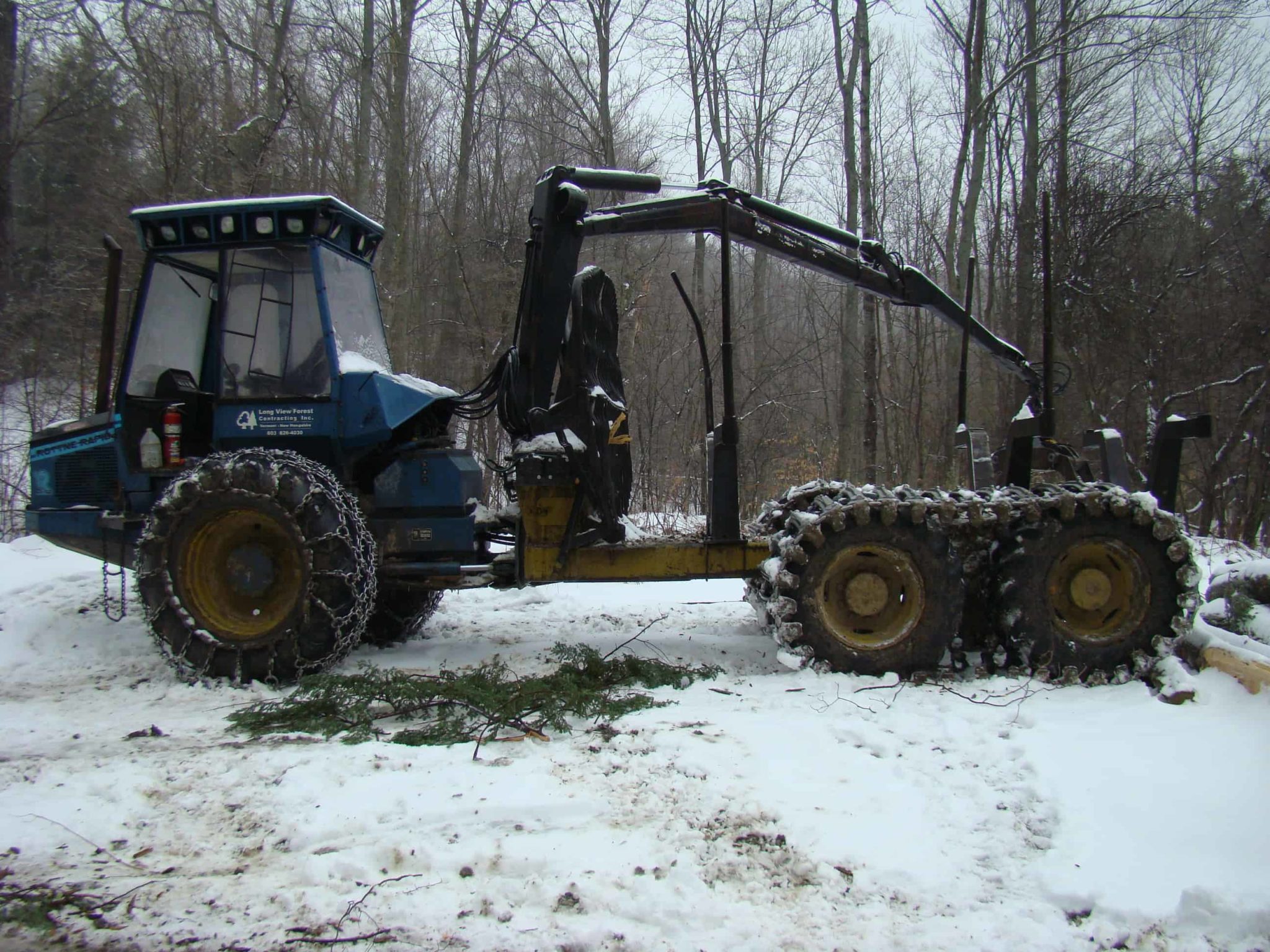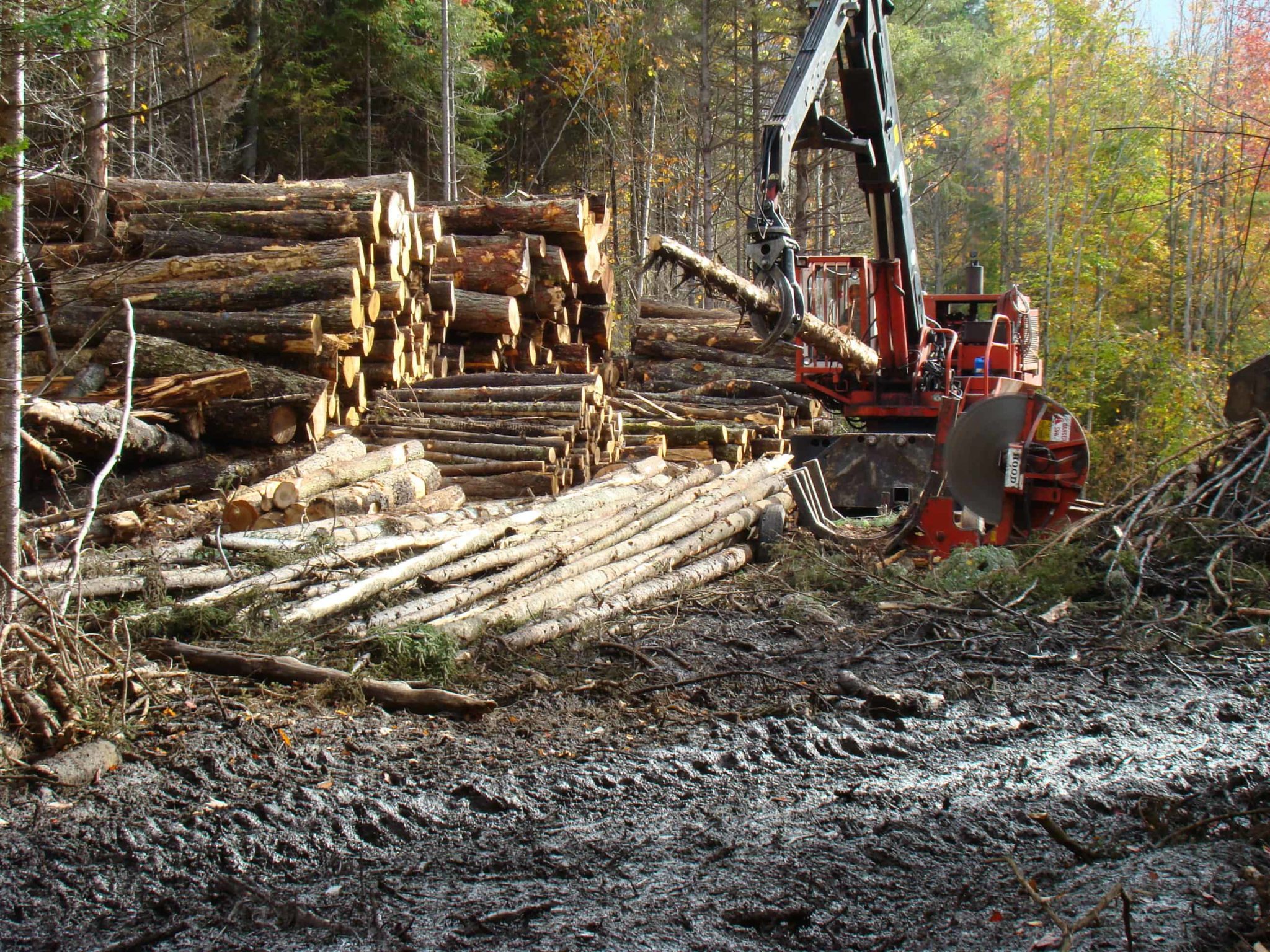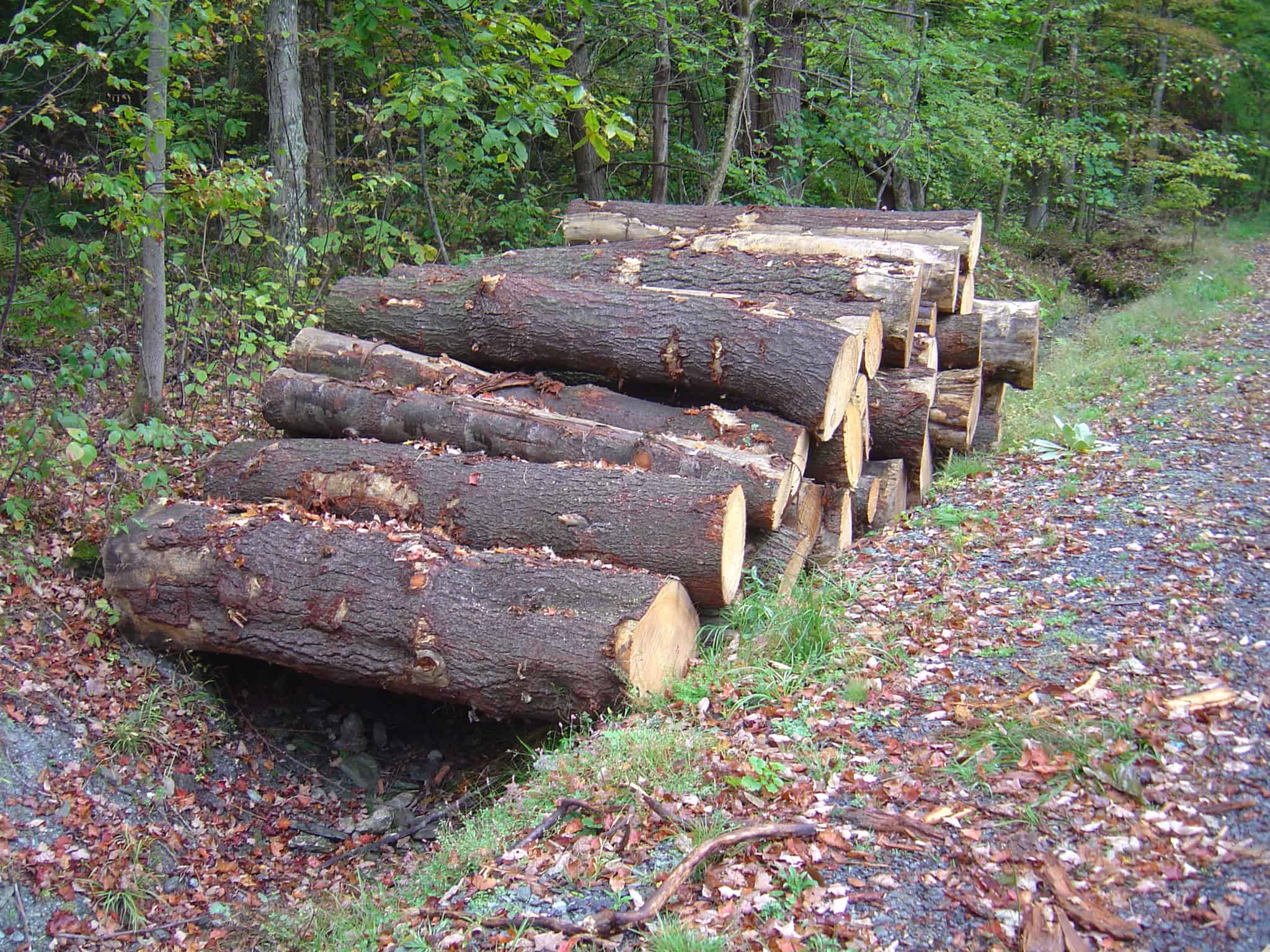Financial Implications of Selling Timber
The Right vs. the Wrong Way
by Peter Smallidge

Different types of logging equipment are available. Loggers with the right equipment for the terrain and conditions will be more efficient and better able to limit damage to the residual trees in the woods.
Timber in farm woodlots and rural woodlands may offer economic opportunities for the landowner. In addition to best management practices that protect the health and productivity of your woods, there are also financial considerations for the owner’s attention. Selling timber includes special tax considerations, but at a more basic level is harvesting the appropriate action for your forest. The amount paid for some species varies from year to year and you should talk with your forester to know the best timing for value and the objectives you have for your forest. If selling timber is the appropriate action for your forest, there are some tax issues you should consider before jumping into the market.
Two general points warrant mention concerning tax issues. First, timber taxes are a special case of federal tax law. As such, tax considerations are usually complex and you should discuss the details of your personal situation with your tax preparer and forester. Second, any time you receive money for timber or logs, you are required by federal and state law to report that income. Timber buyers or the sawmill will provide 1099 forms to forest owners. Form 1099 is used to report income other than wages. The IRS is increasingly sensitive to the number of people who receive timber income but don’t report that income.
Your goal, of course, is to maximize your return while fulfilling your obligation to pay taxes on the sale of timber. When you sell timber, your revenue will either be taxed as Ordinary Income or Capital Gains. The tax rate for ordinary income is higher than capital gains tax rates. Further, revenue that you report as ordinary income may trigger your obligation to pay a self-employment tax up to 15.3% and possibly worker’s compensation. Your tax advisor can help you determine these payments. The landowner’s best tax advantage usually is through the provisions of capital gains. To qualify for long-term capital gains, the timber must be held for personal use or as an investment and the forest owner must have owned the trees for at least 366 days. Qualification for capital gains also depends on how the timber is sold or disposed.

In most circumstances, farmers and woodlot owners will have their best experience with timber harvesting if they work with a carefully selected forester and logger.
The federal tax code relating to selling timber, interpreted through the Department of the Treasury and enforced by the IRS, recognizes three strategies for generating revenue from trees on private forest land known as “disposal of timber.” Note that “timber” is defined as trees that are still attached to the stump or Christmas trees more than 6 years old when cut. The method of disposal partially determines your tax obligation. The three strategies to dispose of timber are: (1) outright sale of timber; (2) pay as cut; and (3) election to treat cutting as sale. Although not a disposal of “timber”, another option is to sell on a percentage basis. Lengthy legal definitions for these are available, but the layman’s definitions follow:
- Outright Sale – Forest owners often call an outright sale a “lump sum” sale, where the buyer pays the owner a fixed, total amount before any cutting occurs. Thus, the trees designated for sale in the contract belong to the buyer when they are cut. The money paid is fixed and no adjustment is made between buyer and seller if the trees change in value or timber markets change. This option provides both tax and logistical advantages to forest owners.
- Pay-as-cut disposal of timber is characterized by the buyer and seller agreeing on the unit price for the timber (e.g., $/thousand board feet, MBF, usually by species) before any cutting occurs. The unit price and scaling method are part of the contract that grants the buyer the rights to cut the trees that are designated in the contract. The owner retains economic interest in the trees until they are cut and become the buyer’s property. The contract should be a written contract that assigns a unit value to the timber, retains economic interest with the owner, transfers ownership of the tree once cut to the buyer, and defines the method used to scale the logs and determine volume. Owners can be prepaid for the timber, with adjustments made after cutting based on the scale of logs after cutting. This type of transaction is defined under Section 631(b) of the tax code and will qualify for capital gains.
- An “election to treat cutting as a sale” is the sale of cut logs rather than the sale of standing trees. This is often used by the forest industry with integrated operations that include their ownership of forest land and a mill. Most forest owners wouldn’t consider this strategy of disposal unless they were selling logs roadside. As such, if the trees were cut and sold by the owner either roadside or delivered to the mill, it is ordinary income unless a Section 631(a) election is made to designate part of the gains as capital gains. For an owner to use a 631(a) transaction requires adherence to the numerous and rather onerous provisions of that section of the tax code. There are several reasons (see below) why most forest owners will not benefit from this type of activity.
- Percentage Sale – Forest owners might agree to a logging activity where they are paid as a percentage of the sale value. This option, typically a poor choice, is characterized by the transport of logs to a mill where the value of the logs is determined after they are cut and by personnel at the mill. Sometimes the owner and logger have a contract providing the buyer a right to cut. This is not a disposal of timber but rather a sale of logs. Revenue is treated and taxed as ordinary income without the option for the more favorable capital gains treatment.
The method of disposal of the timber has significant bearing on your tax obligation. If you qualify for capital gains, you may save 5% to 20% on revenue taxes over landowners who treat revenue from timber sales as ordinary income. Retired forest owners benefit from capital gains provisions because this revenue does not count towards the amount of income they can earn before their Social Security benefits are reduced. Trees sold on a percentage method are taxed at ordinary income rates and may also require payment of self-employment tax, owners may be held for worker’s compensation insurance, and as noted above may reduce Social Security benefits. There are few if any motivations for most private forest owners to sell trees roadside or through the provisions of section 631(a) because of the loss of capital gains treatments or the complexity of the provisions.

Selling logs “roadside” is seldom if ever in the best interest of farmers and woodlot owners. A stumpage sale, the sale of standing timber that is marked by a forester, is usually better for the owner.
In addition to the requirements of the 631(a) transactions, there are other reasons that most forest owners avoid selling logs roadside. Selling roadside is risky because if the market drops, the trees are already cut and will begin to degrade in quality. Selling roadside also assumes that you or the person working in the woods has the skill and equipment needed to operate safely and avoid damage to the residual trees.
A final thought. You can reduce your tax obligation if you have determined your “basis”. Your basis is the value of the timber, relative to other assets, at the time you acquired it. Your timber basis is essentially the value of your inventory and is best determined as close to the time of taking title to the property as possible. Most land owners will need a forester or an accountant to assist in determining their basis allocations. At the time of a timber sale, determine the proportion of value of the timber when disposed relative to the total original value of timber basis and deduct that from the gross revenue of the sale. You can also reduce your tax obligation by deducting expenses associated with the sale that you paid to your forester, attorney, or surveyor. You are taxed on the gross proceeds minus the timber basis removed minus any sale costs. As a simple example (see your tax preparer for your specific situation): You received $30,000 from your timber sale, your basis removed during the harvest was $22,000 and fees for professional services totaled $1,500 because your forester and attorney charge by the hour. You only pay tax on $6,500 of revenue, with the tax based on either capital gains rates (0%, 5%, or 15%) or on ordinary income rates (10% to 35%) that are higher than capital gains rates.
There are additional provisions of the federal tax code that provide significant financial benefit to private forest owners who are deliberate in the management of their woodlot with the intent of generating a profit. The details are numerous, but you will need a well crafted management plan and a good relationship with a knowledgeable forester and tax preparer. The USDA Handbook #718 is useful and is available at www.timbertax.org, a well-developed website support by the US Forest Service. The IRS’ Form T-Timber can be helpful in various calculations and record keeping even if you are not required to file it. Form T can be found on the IRS site at www.IRS.gov.
Peter Smallidge, NYS Extension Forester, Cornell University Cooperative Extension, Department of Natural Resources, 219 Fernow Hall, Ithaca, NY 14853. He can be contacted at (607) 592-3640 or pjs23@cornell.edu.
For more information about woodlot management, visit the publications, webinar, and Ask Questions links at www.ForestConnect.info


My wife and I are considering buying a plot of land that has quite a bit of timber on it. I had no idea there were so many things to consider when it comes to either maintaining the trees or selling the trees. If we decide to buy this plot, we will have to figure out the best way to take care of our land. Thank you for the insights.
Where do local timber taxes fit in?
I know this is years after the fact, but here in Georgia timber sales are taxed by the county on the property’s millage rate. If you’re still looking for help then contact your county tax office.
Hi Charles,
I haven’t been able to find anything online regarding local timber taxes, but I would suggest reaching out to the author, Peter Smallidge, with your question at (607) 592-3640 or pjs23@cornell.edu.
In ’73 I purchased 19+ acres of farm land (the value of resident timber was negligible) from Atlantic Pulpwood and Timber Corp. and soon with $$ assist from USDA had it planted in loblolly w/my out-of-pocket cost approx $850. Since there was no appraisal, can I determine the value of the timber at the time of acquisition as ZERO?
Hi Milton. Thank you for reaching out, and sorry for the late reply from us. Unfortunately, our small office does not have a timber specialist. However, Peter Smallidge, the author of this arcitle, may be able to help you with your question. He can be contacted at (607) 592-3640 or pjs23@cornell.edu.
Charles ,
We are selling 1700 acres of timberland in western central New York . Isn’t there a specific formula to figure if we should sell land with or without the timber? Realtors are estimating one price and when using Doyle rule to calculate our timber it’s almost a million more? Should we harvest before selling even if it would lower land value ? We have 40% black cherry and that seems to be going up in value. Thanks for any suggestions. How do you find out if forester is certified? Thanks, Jeanette
Hi Jeanette, thanks for your questions. I’d suggest contacting the author of this article, Peter Smallidge, directly. He can be reached at (607) 592-3640 or pjs23@cornell.edu and may have suggestions and answers for you.
I own a 100 acre Walnut tree farm. I decided last year to start harvesting the trees myself,& take them to a local sawmill to sell. I asked the sawmill for a W2 for my taxes & they told me they don’t do that. For tax purposes how do I proceed? & do landowners who harvest there own trees receive any tax breaks? I’m sure I know the answer to that one but I thought I would ask.
Hi Thad,
Thanks for reaching out. We don’t have a timber specialist in our Small Farms office, so I’d recommend getting in touch with the author of this article, Peter Smallidge. He can be reached at (607) 592-3640 or pjs23@cornell.edu. Best of luck!
I found it very interesting when you talked about how timber sales are a special case under federal tax law. I’m looking at purchasing a property with a lot of timber on it and have been considering how to handle it all. Thank you for the information about discussing the details with your tax preparer and forester.
If you cut your own timber to sell as house logs ate you required to collect a Sales Use Tax
from the buyer on those logs
If my buyer gave me a set price per ton on the various cuts, then is that pay as cut?
Very helpful article with important information
Hi I just sold some timber roughly 10-12 acres and feel like I have been worked over by the logger. Of course here everything is done on a hand shake. I had 3 different loggers come out and none would put anything in writing. I do have text showing everything im about to say about this logger. He is licensed, insured, and has a LLC. So against my better judgment I went with one anyway. Well he had equipment failures and will not be back. When I asked for the 1099 on the approximate 20k I was paid he said don’t worry about it I pay all the taxes and it’s filed as royalties so you don’t show anything. Well quite a few checks were over $600 so I know the bank reports that. What should I do is there anything legally I should do? I have looked it up and I know I have to pay taxes but how do I file with no 1099? I believe from my research that capital gains should be the best in my interest because I have owned the property more that 366 days. Any info or advice would be appreciated.